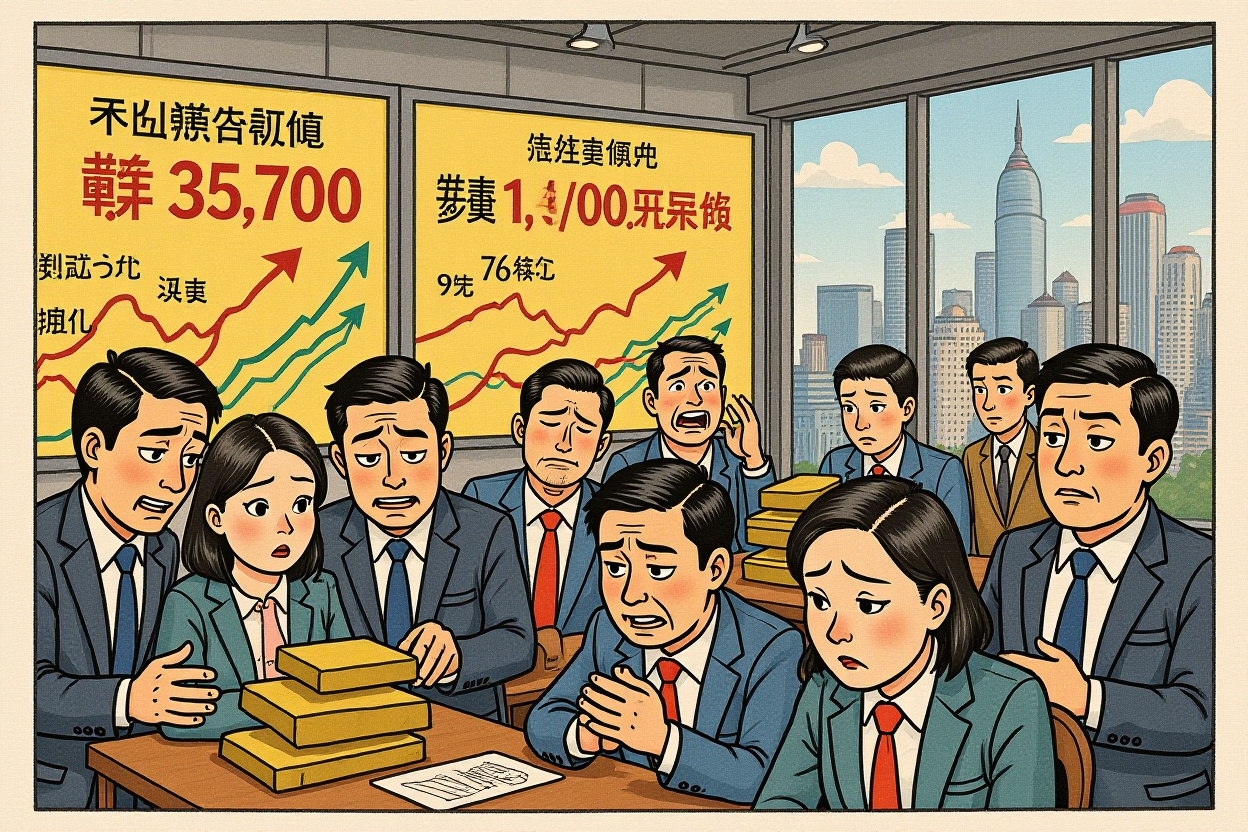Gold Breaks $3,700 Barrier as Fed Rate Decision Looms
Spot gold prices reached an unprecedented $3,703.13 per ounce on September 16, marking the first time the precious metal has broken through the $3,700 threshold. This represents a staggering $1,076 per ounce increase year-to-date, reflecting extraordinary market momentum ahead of the critical Federal Reserve rate decision.
The dollar index simultaneously fell below the 97 level, declining 0.61% to 96.7591. Market analysts attribute these movements to weakening U.S. employment data that has strengthened expectations for Federal Reserve rate cuts. The upcoming Federal Reserve rate decision has become the primary catalyst for global market repositioning.
Executive Summary: Critical Market Developments
– Gold prices hit historic high of $3,703.13/oz, up $1,076 year-to-date
– Dollar index drops 0.61% to 96.7591, breaking below key 97 support level
– Markets price in 95.8% probability of 25-basis-point Fed rate cut
– Major banks upgrade gold targets, with Morgan Stanley forecasting $3,800 by year-end
– Fed governance changes add uncertainty to monetary policy direction
Federal Reserve Rate Decision Dynamics Shift
The Federal Open Market Committee meeting scheduled for September 16-17 represents a pivotal moment for global markets. With the Federal Reserve rate decision announcement expected at 2:00 AM Beijing time on September 18, followed by Chairman Jerome Powell’s press conference at 2:30 AM, traders are positioning for potential volatility across asset classes.
CME FedWatch Tool data indicates markets have priced in a 95.8% probability of a 25-basis-point cut, with a 4.2% chance of a more aggressive 50-basis-point reduction. The certainty of easing reflects deteriorating economic indicators and shifting Fed priorities toward supporting employment markets.
Governance Changes Add Complexity to Federal Reserve Rate Decision
Significant changes to the Federal Reserve’s voting roster have introduced additional uncertainty into the Federal Reserve rate decision process. The Senate narrowly approved Stephen Milan (斯蒂芬·米兰) as Fed governor by a 48-47 vote on September 15. Milan, who holds a Harvard economics doctorate and previously served as Senior Advisor for Economic Policy at the Treasury Department during Trump’s first term, will participate in the current meeting.
Simultaneously, the D.C. Circuit Court of Appeals rejected President Trump’s attempt to remove Governor Lisa Cook from her position. Unless the Supreme Court intervenes, Cook will retain her voting rights during this critical Federal Reserve rate decision. These governance changes come as Trump-appointed governors Bowman and Waller already demonstrated dovish tendencies by dissenting in favor of rate cuts during the July meeting.
Institutional Gold Forecasts Reach Historic Levels
Financial institutions have aggressively revised gold price targets following the metal’s breakthrough above $3,700. Morgan Stanley now projects year-end targets of $3,800 per ounce, emphasizing the strong negative correlation between gold and the U.S. dollar. The bank’s analysis suggests continued dollar weakness would directly benefit dollar-denominated precious metals.
UBS had previously forecast $3,700 gold by June 2026, a target already exceeded months ahead of schedule. The Swiss bank now acknowledges potential for $4,000 gold in scenarios involving deteriorating geopolitical or economic conditions. This accelerated timeline demonstrates how rapidly market dynamics are evolving around the Federal Reserve rate decision expectations.
Investor Demand Replaces Central Banks as Primary Catalyst
JPMorgan research identifies a fundamental shift in gold market dynamics. Whereas central bank accumulation previously drove price appreciation, investor demand has now become the primary catalyst. Based on surging investment flows, JPMorgan expects Q4 2025 averages of $3,800 per ounce with Q1 2026 breakthroughs above $4,000 – a full quarter earlier than previous projections.
Goldman Sachs maintains its year-end $3,700 target while projecting $4,000 by mid-2026. The bank highlights scenario risks involving impaired Federal Reserve independence, suggesting that if retail investors mirror central bank diversification behavior, prices could exceed $4,500. In an extreme case where 1% of U.S. Treasury holdings shift to gold, prices might approach $5,000 per ounce.
Chinese Analysts Voice Short-Term Caution
Despite bullish international forecasts, domestic Chinese institutions are highlighting potential near-term risks. Bian Quanshui (边泉水), Chief Macro Analyst at Western Securities, attributes gold’s record highs to credit risk and evolving ‘Federal Reserve trust crisis’ narratives. While political and trade uncertainties support continued diversification demand, he acknowledges sustainability concerns at current levels.
Meng Xiangwen (孟祥文), Nonferrous Metals Analyst at Soochow Securities, notes that since the August Jackson Hole symposium elevated Fed focus on employment markets, moderate commodity inflation won’t alter the pace of rate cuts. Weakening labor markets combined with tariff-induced inflation and declining nominal rates should continue benefiting precious metals.
Technical Indicators Suggest Potential Pullback Risk
Qian Wei (钱伟), Chief Overseas Economy and Macro Asset Analyst at China Securities, observes that the January-April rally to $3,500 primarily reflected Trump policy uncertainties. With potential trade缓和 and recovery narratives gaining traction in second-half 2025, gold’s short-term bullish factors may be less compelling. If global equity markets strengthen or Ukraine conflict de-escalates, risk appetite recovery could trigger significant corrections from historic highs.
Xu Ying (徐颖), Chief Macro Strategist at Orient Futures, notes that domestic Chinese gold has consistently underperformed international markets, maintaining discount conditions while physical selling pressure increases. Following the latest record highs, market volatility will likely accelerate, warranting caution regarding near-term correction risks.
Strategic Implications for Global Investors
The evolving Federal Reserve rate decision framework has profound implications for international portfolio allocation. Non-U.S. central banks easing ahead of the Fed has created global liquidity溢出 effects that particularly benefit gold. For Chinese equity market participants, understanding these cross-border capital flows becomes essential for positioning during monetary policy transitions.
Historical analysis suggests that Federal Reserve pivots often trigger extended commodity cycles, particularly when coinciding with dollar weakness. The current environment combines unprecedented fiscal stimulation, geopolitical fragmentation, and institutional dollar diversification – creating ideal conditions for sustained precious metal appreciation.
Navigating Uncertainty in Chinese Equity Markets
For sophisticated investors focused on Chinese equities, the Federal Reserve rate decision creates both challenges and opportunities. While dollar weakness typically supports emerging market assets, including Chinese stocks, the gold rally may divert capital from equity allocations. Sector-specific impacts will vary, with gold miners and precious metal exporters potentially outperforming while rate-sensitive technology shares face headwinds.
The People’s Bank of China (中国人民银行) will likely maintain its cautious monetary policy stance regardless of Fed actions, focusing on domestic stability rather than following U.S. rate cuts. This policy divergence may create unique arbitrage opportunities between Chinese and U.S. assets, particularly for institutional investors with cross-border capabilities.
Forward-Looking Investment Considerations
The Federal Reserve rate decision represents a inflection point for global capital markets. While immediate reaction will focus on the rate cut magnitude and forward guidance, longer-term implications involve fundamental reassessment of dollar reserve status and alternative store-of-value assets.
Prudent investors should monitor several key indicators beyond the immediate Federal Reserve rate decision: real yield movements, central bank gold accumulation patterns, geopolitical developments, and physical market supply-demand dynamics. These factors will determine whether current price levels represent sustainable breakthroughs or speculative excess.
For time-sensitive decision makers, establishing position sizes that account for both bullish scenarios and correction risks remains essential. Consider staggered entries rather than full allocation at current levels, and maintain flexibility to adjust exposure as new information emerges from subsequent Fed communications and economic data releases.
Monitor Federal Reserve communications closely through official channels including their website for ongoing policy guidance. Professional investors should also track CME FedWatch Tool for evolving rate expectations and COMEX futures positioning for sentiment indicators.




